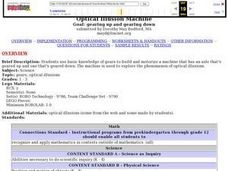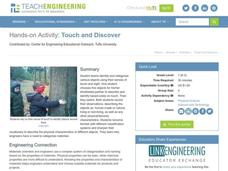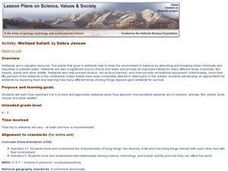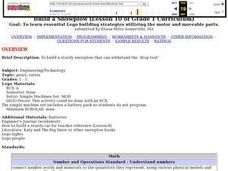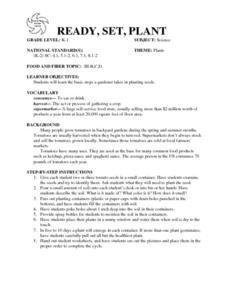Curated OER
Where's The Drip?
Pupils explore the school and report back any leaks they see to the teacher. They are encouraged to do this at home and report any leaks to their parents.
Curated OER
Biodegradable Plastics
Students prepare a type of biodegradable plastic. They design method(s) to compare its properties with some common plastics that are readily available in the market. They later advance to identifying variables in an experiment and fair...
Curated OER
Mammals of Wisconsin
Young scholars explore the exciting world of mammals as they learn the identities of some Wisconsin native residents. They examine their adaptations and learn how they survive in a state with a wide array of temperatures and ecosystems.
Curated OER
Pond Exploration
Students take a hands-on approach to explore the world beneath the water in this activity. They examine the creatures they catch to study about the adaptations these animals have that allow them to survive in this harsh environment. They...
Curated OER
Learning Activities: Observing Using Sight
Students describe how diffusion occurs within a liquid. They explain a situation where diffusion through a liquid might occur in the natural world.
Curated OER
Newton's Third Law
Learners use inquiry and observation to explore Newton's third law of motion: for every action there is a reaction. In this physics activity, students rotate through six stations set up with materials and picture directions illustrating...
Curated OER
Optical Illusion Machine
Students explore optical illusions. Using Legos, they construct and motorize a machine that has an axle that's geared up and geared down, complete a worksheet, and answer discussion questions.
Curated OER
Touch and Discover
Students work together to identify and categorize objects. They have to identify the object on touch because they are blindfolded. They record their data and describe the objects once they can look at them.
Curated OER
Five Senses
Students listen to the book "My Five Senses." They work together to classify fifteen objects by the sense that they affect. They discuss the sense organs and complete a chart. Finally, they sort mystery items from a bag which the teacher...
Curated OER
Wetland Safari!
Pupils identify how humans, fish, plants, birds, insects and other wildlife benefit from wetland environments. They observe a wetland and its inhabitants, draw a migration map that represents how birds use wetlands in traveling long...
Curated OER
H2O in Us
Young scholars discover through this activity that all organisms are composed of water. They find that 70 percent of their bodies are made up of water that is in thier cells and blood, and not free-flowing throughout their body.
Curated OER
Build a Snowplow
Learners design and build a snowplow using LEGO materials. They compete in an Engineer's Challenge to clear a path through Styrofoam peanuts.
Curated OER
Earth/Globe (poles & equator)
First graders create his/her own paper mache earth and label the poles and equator. The land masses can be added and labeling of specific bodies of water. The paper mache earth can then be used to discuss the sun, moon, and the earth and...
Curated OER
READY, SET, PLANT
Students identify the basic steps a gardener takes in planting seeds. Students identify the many uses of tomatoes. Students examine the seeds and try to identify them. Students place their plants in a sunny window and water them when...
Curated OER
Investigating Erosion in an Outdoor Classroom
First graders observe the effects of erosion. They work in groups to simulate erosion in a streambed, participate in class discussion, read books about fossils and rocks and then go on a fossil hunt.
Curated OER
Water Conservation Task
Students list reasons that water conservation is important. They describe methods to conserve water. This lesson could be incorporated with an oral hygiene lesson on brushing teeth.
Curated OER
Why is the Sea Salty?
Students conduct a hands-on activity to investigate salt concentrations in water and how salt remain after water evaporates. They can also do a Saltwater Painting to once again observe the evaporation. process.
Curated OER
My Little Seed House
First graders chart the growth and development of seeds. In this seed growth lesson, 1st graders observe seeds as they mature through the growing process.
Curated OER
Can You Match Them?
Students find pairs of matching sounds by shaking lidded containers and listening to the sounds that are generated.
Curated OER
Worms in a Bottle
Students gain a better understanding of the worm and its role in the recycling of organic materials into simpler forms by constructing worm bottles and observing for 60 to 90 days.
Curated OER
A Worm World
Students maintain a compost bin and build a worm observatory. They design experiments relating to worms and record observations in a worm journal.
Curated OER
Wood Products
Pupils examine wood samples and find and identify various items at school and at home that are made from wood products.
Curated OER
Wood Types/Porosity
Learners examine hardwoods and their pores. They discover that some pores allow for air movement while others do not. They also examine and identify the different types of hardwoods.
Curated OER
How Does the Wind Blow?
Students discover how the air makes objects move. They use a straw and paper with paint on it to test how hard they need to blow to make the paper move. They create mobiles and watch how they move when a window is open. They discuss what...








